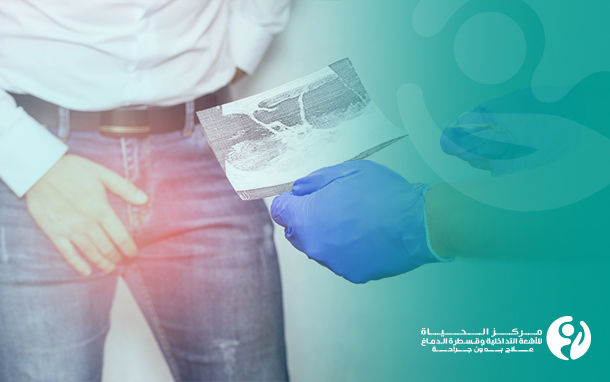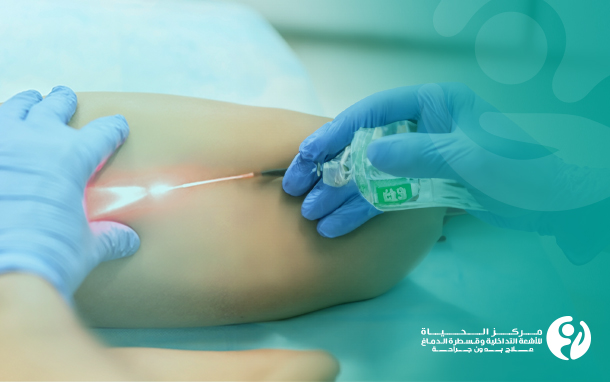Treatment of Varicose Veins with Interventional Radiology
Varicose veins are a common condition that affects many people around the world. Varicose veins are characterized by swelling and dilation of veins in the legs. Varicose veins are both an aesthetic and a health issue. Although many available treatment options for varicose veins, interventional radiology has proven its effectiveness and safety in many cases. In this article, we will explore interventional radiology and its role in the non-surgical treatment of varicose veins.
Varicose veins:
Varicose veins occur in the veins located near the skin of the leg due to the malfunction of the veins' valves, which help the blood move against gravity toward the heart. These valves open and close to prevent the backflow of blood towards the ankle. When the valves become leaky, the blood pools in the veins, leading to their swelling and the development of varicose veins.
Varicose veins are a very common problem, affecting both women and men. Initially, the condition may be asymptomatic, but after time, the symptoms may worsen and require treatment.
Symptoms of varicose veins:
1. Swelling in the legs and ankles.
2. Pain and heaviness in the legs may increase after standing or walking for long periods.
3. Itching in the legs.
4. Visible blue and twisted veins under the skin.
5. Potential skin changes, such as discoloration and dryness.
Varicose veins tend to progress over time if left untreated. As the veins become more dilated and twisted, the blood cannot return efficiently from the legs to the heart. This impaired blood flow leads to further blood accumulation in the veins, putting extra pressure on them, thus increasing their size and visibility.
Complications of varicose veins:
Varicose veins can progress to serious complications over time, such as:
1. Superficial phlebitis: This is the inflammation of the superficial veins, which can cause pain, redness, and swelling in the affected area.
2. Leg ulcers: Skin ulcers may develop due to poor blood flow in the damaged veins, which requires immediate medical care.
The need for treatment of varicose veins depends on the severity of the symptoms and their impact on the patient's quality of life. If the symptoms are mild and do not cause significant problems, you should make lifestyle changes and practice self-care:
1. Perform light exercise and walk to enhance blood flow in the legs.
2. Avoid prolonged standing or sitting without breaks.
3. Raise your legs while sitting or sleeping.
4. Avoid crossing your legs while sitting.
5. Apply pressure to the legs by wearing comfortable and suitable compression stockings or elastic bandages to support the veins and improve blood flow.
If the symptoms do not improve after following these recommendations, you may need to consider advanced medical treatment as the role of interventional radiology in varicose veins treatment becomes evident.
Interventional radiology for the non-surgical treatment of varicose veins:
Al Hayat Center for Interventional Radiology and Neurointervention in Iraq offers the latest techniques for the non-surgical treatment of varicose veins in just 30 minutes, using interventional radiology with the latest medical devices. Interventional radiology is a non-surgical procedure that uses laser or radiofrequency energy to generate heat and close the dilated vein.
The treatment of varicose veins with interventional radiology involves the following steps:
1. The treatment area is anesthetized using a local anesthetic.
2. The interventional radiologist makes a small incision in the skin near the affected vein and inserts a small tube called a catheter into the vein.
3. Electromagnetic energy is used to guide the laser beams towards the varicose veins.
4. The device at the tip of the catheter heats the vein walls, causing them to become rigid and contract, reducing the size of the veins and closing them. Branched veins and skin capillaries may also be injected with adhesive materials.
5. After the damaged veins are closed, the blood flow improves in the adjacent healthy veins.
Advantages of interventional radiology in the treatment of varicose veins:
• One of the main advantages of interventional radiology is that it is a non-surgical procedure, meaning there is no need for traditional surgery, thus avoiding the associated risks.
• Interventional radiology does not require general anesthesia and can be performed quickly in an outpatient clinic without hospital admission.
• This treatment is characterized by a shorter recovery period and a faster return to normal life.
• The patient can return home on the same day of the procedure.
• The recurrence rate of varicose veins after interventional radiology is extremely low.
Key questions and answers about thermal ablation treatment for varicose veins:
Can I walk after treating varicose veins with interventional radiology?
The medical team at Al Hayat Center for Interventional Radiology and Neurointervention encourages patients to start walking immediately after the procedure while avoiding strenuous exercises like weightlifting for 2-3 weeks to allow for complete healing and vein closure.
What are the side effects of interventional radiology treatment for varicose veins?
Common side effects after most surgical procedures for treating dilated veins include redness, temporary swelling, skin discoloration, and mild pain. However, the side effects are more severe with traditional vein removal surgery.
How painful is interventional radiology for varicose veins?
Common side effects after interventional radiology treatment of varicose veins include mild pain. However, one of the goals of this procedure is to relieve the pain caused by varicose veins, improve the appearance of the veins, and prevent other health complications such as pain, blood clots, or skin ulcers.
What is the risk of varicose vein recurrence after interventional radiology treatment?
Varicose veins cannot be permanently prevented but can be treated with interventional radiology therapy. The patient also needs to make lifestyle changes that can prevent the worsening of varicose veins, reduce pain, and delay the formation of new varicose veins. Interventional radiology has achieved lower recurrence rates compared to traditional surgery.
Comparison between the treatment of varicose veins using interventional radiology and surgical treatment:
Interventional radiology for treating varicose veins is considered more effective and preferred by many than traditional surgery. Here are some of the main advantages of interventional radiology compared to traditional surgery:
1. Non-surgical: Interventional radiology is a non-surgical procedure; there is no need for traditional surgeries that involve general anesthesia and skin incision.
2. Minimally invasive: Interventional radiology involves a small skin incision and a thin catheter to access the dilated vein, resulting in less intervention and less pain after the procedure.
3. Faster recovery: Patients generally recover more quickly after interventional radiology treatment than traditional surgery, as many patients can return to their daily activities in a shorter time.
4. Less pain: Many people experience less pain and swelling after interventional radiology than traditional surgery.
5- Local anesthesia: Usually, only the area surrounding the vein is anesthetized in interventional radiology treatment, while traditional surgery requires general anesthesia, which can conflict with the health status of many people who cannot stand the risks of general anesthesia.
6- High safety: Interventional radiology is a safe procedure for treating varicose veins, as it does not require general anesthesia and ensures reducing the risks of traditional surgical intervention.
7- No need for hospitalization: Interventional radiology can usually be performed in a medical center, Al Hayat Center for Interventional Radiology and Neurointervention in Iraq, while traditional surgery requires hospitalization.
8- Better cosmetic results: Most patients enjoy better cosmetic results after interventional radiology, as it usually leaves no major scars.
9- High effectiveness: Interventional radiology is effective in closing dilated veins and improving varicose vein symptoms with high success rates.
In conclusion, interventional radiology at Al Hayat Center for Interventional Radiology and Neurointervention in Karbala is an effective and safe option for treating varicose veins. This technique improves symptoms and the aesthetic appearance of the legs while avoiding the complications and risks associated with traditional surgery. Patients suffering from varicose veins should consult their physicians to evaluate the potential benefits of interventional radiology and achieve the best results in managing their condition.

